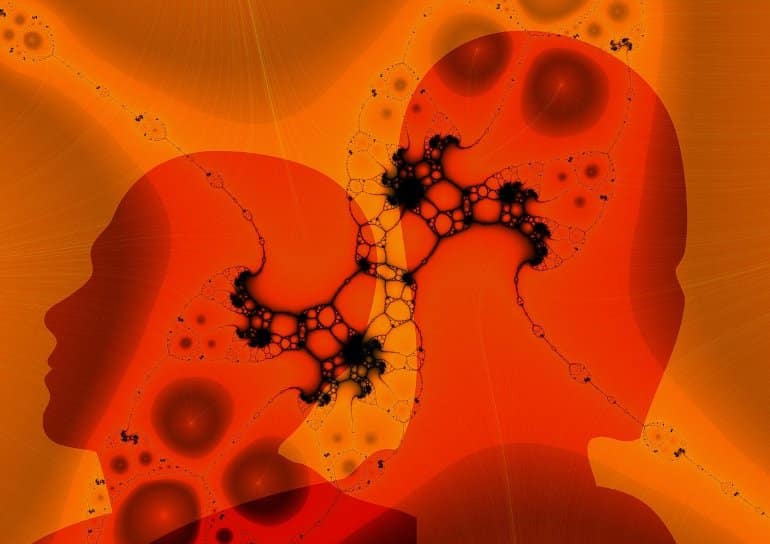Summary: Regardless of symptom severity, otherwise healthy young people diagnosed with COVID-19 develop abnormalities with the system that governs the fight-or-flight response in the sympathetic nervous system.
Source: Journal of Physiology
New research published in the Journal of Physiology found that otherwise healthy young people diagnosed with COVID-19, regardless of their symptom severity, have problems with their nervous system when compared with healthy control subjects.
Specifically, the system that oversees the fight-or-flight response, the sympathetic nervous system, seems to be abnormal (overactive in some instances and underactive in others) in those recently diagnosed with COVID-19.
These results are especially important given the emerging evidence of symptoms like racing hearts being reported in conjunction with “long-COVID.”
The impact of this alteration in fight-or-flight response, especially if prolonged, means that many processes within the body could be disrupted or affected. This research team has specifically been looking at the impact on the cardiovascular system—including blood pressure and blood flow—but the sympathetic nervous system is also important in exercise responses, the digestive system, the immune function, and more.
Understanding what happens in the body shortly following diagnosis of COVID-19 is an important first step towards understanding the potential long-term consequences of contracting the disease.
Importantly, if similar disruption of the flight-or-fight response, like that found here in young individuals, is present in older adults following COVID-19 infection, there may be substantial adverse implications for cardiovascular health.
The researchers studied lung function, exercise capacity, vascular function, and neural cardiovascular control (the control of heartbeat by the brain).
They used a technique called microneurography, wherein the researchers inserted a tiny needle with an electrode into a nerve behind the knee, which records the electrical impulses of that nerve and measures how many bursts of electrical activity are happening and how big the bursts are.
From this nerve activity, they can assess the function of the sympathetic nervous system through a series of tests. For all the tests, the subject was lying on their back on a bed. First, the researchers looked at the baseline resting activity of the nerves, heart rate, and blood pressure. Resting sympathetic nerve activity was higher in the COVID-19 participants than healthy people used as controls in the experiment.
Then, the subject did a “cold pressor test,” where they stick their hand in an ice-water mixture (~0° C) for two minutes. In healthy individuals, this causes a profound increase in that sympathetic nerve (fight-or-flight) activity and blood pressure. The COVID-19 subjects rated their pain substantially lower than healthy subjects typically do.
Finally, the participant was moved to an upright position (the bed they’re lying on can tilt up and down) to see how well their body can respond to a change in position. The COVID-19 subjects had a pretty large increase in heart rate during this test; they also had higher sympathetic nerve activity throughout the tilt test compared with other healthy young adults.
As with all research on humans, there are limitations to this study. However, the biggest limitation in the present study is its cross-sectional nature—in other words, we do not know what the COVID-19 subjects’ nervous system activity “looked like” before they were diagnosed with COVID-19.
These findings are consistent with the increasing reports of long-COVID symptoms pertaining to problems with the fight-or-flight response.
Abigail Stickford, senior author on this study said, “Through our collaborative project, we have been following this cohort of COVID-19 subjects for six months following their positive test results. This work was representative of short-term data, so the next steps for us are to wrap up data collection and interpret how the subjects have changed over this time.”
Specifically, the system that oversees the fight-or-flight response, the sympathetic nervous system, seems to be abnormal (overactive in some instances and underactive in others) in those recently diagnosed with COVID-19.
These results are especially important given the emerging evidence of symptoms like racing hearts being reported in conjunction with “long-COVID.”
The impact of this alteration in fight-or-flight response, especially if prolonged, means that many processes within the body could be disrupted or affected. This research team has specifically been looking at the impact on the cardiovascular system—including blood pressure and blood flow—but the sympathetic nervous system is also important in exercise responses, the digestive system, the immune function, and more.
Understanding what happens in the body shortly following diagnosis of COVID-19 is an important first step towards understanding the potential long-term consequences of contracting the disease.
Importantly, if similar disruption of the flight-or-fight response, like that found here in young individuals, is present in older adults following COVID-19 infection, there may be substantial adverse implications for cardiovascular health.
The researchers studied lung function, exercise capacity, vascular function, and neural cardiovascular control (the control of heartbeat by the brain).
They used a technique called microneurography, wherein the researchers inserted a tiny needle with an electrode into a nerve behind the knee, which records the electrical impulses of that nerve and measures how many bursts of electrical activity are happening and how big the bursts are.
From this nerve activity, they can assess the function of the sympathetic nervous system through a series of tests. For all the tests, the subject was lying on their back on a bed. First, the researchers looked at the baseline resting activity of the nerves, heart rate, and blood pressure. Resting sympathetic nerve activity was higher in the COVID-19 participants than healthy people used as controls in the experiment.

Then, the subject did a “cold pressor test,” where they stick their hand in an ice-water mixture (~0° C) for two minutes. In healthy individuals, this causes a profound increase in that sympathetic nerve (fight-or-flight) activity and blood pressure. The COVID-19 subjects rated their pain substantially lower than healthy subjects typically do.
Finally, the participant was moved to an upright position (the bed they’re lying on can tilt up and down) to see how well their body can respond to a change in position. The COVID-19 subjects had a pretty large increase in heart rate during this test; they also had higher sympathetic nerve activity throughout the tilt test compared with other healthy young adults.
As with all research on humans, there are limitations to this study. However, the biggest limitation in the present study is its cross-sectional nature—in other words, we do not know what the COVID-19 subjects’ nervous system activity “looked like” before they were diagnosed with COVID-19.
These findings are consistent with the increasing reports of long-COVID symptoms pertaining to problems with the fight-or-flight response.
Abigail Stickford, senior author on this study said, “Through our collaborative project, we have been following this cohort of COVID-19 subjects for six months following their positive test results. This work was representative of short-term data, so the next steps for us are to wrap up data collection and interpret how the subjects have changed over this time.”
About this COVID-19 and neurodevelopment research news
Source: Journal of Physiology
Contact: Press Office – Journal of Physiology
Image: The image is in the public domain
Original Research: Open access.
“COVID‐19 is getting on our nerves: Sympathetic neural activity and hemodynamics in young adults recovering from SARS‐CoV‐2” by Nina L. Stute et al. Journal of Physiology
Abstract
COVID‐19 is getting on our nerves: Sympathetic neural activity and hemodynamics in young adults recovering from SARS‐CoV‐2
The novel severe acute respiratory syndrome coronavirus 2 (SARS-CoV-2) can elicit systemic adverse physiologic effects. However, the impact of SARS-CoV-2 on autonomic and cardiovascular function in otherwise healthy individuals remains unclear.
Young adults who tested positive for SARS-CoV-2 (COV+; n = 16, 8F) visited the laboratory 35±16 days following diagnosis. Muscle sympathetic nerve activity (MSNA), systolic (SBP) and diastolic (DBP) blood pressure, and heart rate (HR) were measured in subjects at rest and during a 2-min cold pressor test (CPT) and 5 min each at 30° and 60° head-up tilt (HUT). Data were compared with age-matched healthy controls (CON; n = 14, 9F). COV+ participants (18.2±6.6 bursts·min–1) had higher resting MSNA burst frequency compared with CON (12.7±3.4 bursts·min–1) (p = 0.020), as well as higher MSNA burst incidence and total activity. Resting HR, SBP, and DBP were not different.
During CPT, the change in total MSNA from baseline to peak was +71 a.u.∙min–1 in COV+ and +545 a.u.∙min–1 in CON (p = 0.008); there were no differences in HR, SBP, or DBP. COV+ subjects reported less pain during the CPT compared with CON (5.7±1.8 vs. 7.2±1.9 a.u., p = 0.036). MSNA was higher in COV+ compared with CON during HUT. There was a group-by-position interaction in MSNA burst incidence, as well as HR, in response to HUT.
These results indicate resting sympathetic activity, but not HR or BP, may be elevated following SARS-CoV-2 infection.
Further, cardiovascular and perceptual responses to physiological stress may be altered – including both exaggerated (orthostasis) and suppressed (pain) responses compared with healthy young adults.






